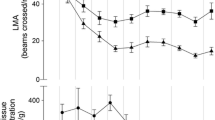Abstract
Non-deprived rats were allowed 1-h access to a range of saccarin solutions from 0.001 to 0.1 M Na saccharin. Compared to a group of rats drinking tap water, the rats drinking the saccharin solutions ingested a great deal more fluid, with as much as 24–30 ml consumed of the 0.01 M concentration, compared to 3–5 ml in controls. Fluoxetine (IP) decreased this palatability-induced excessive consumption in a dose-related manner. Effects of 10 mg/kg fluoxetine were apparent for 48 h after injection. This effect on palatability-induced ingestion may relate to previously reported effects of fluoxetine on food consumption.
Similar content being viewed by others
References
Barrett AM, McSharry L (1975) Inhibition of drug-induced anorexia in rats by methysergide. J Pharm Pharmacol 27:889–895
Blundell JE (1977) Is there a role for serotonin (5-hydroxytryptamine) in feeding? Int J Obes 1:15–42
Blundell JE, Latham CJ (1979) Serotonergic influences on food intake: Effect of 5-hydroxytryptophan on parameters of feeding behavior in deprived and free-feeding rats. Pharmacol Biochem Behav 7:431–437
Blundell JE, Leshem MB (1975) The effect of 5-hydroxytryptophan on food intake and on the anorexia action of amphetamine and fenfluramine. J Pharm Pharmacol 27:31–37
Clineschmidt BV, McGuffin JC, Pflueger AB, Totaro JA (1978) A 5-hydroxytryptamine-like mode of anorectic action for 6-chloro-2-[1-piperazinyl]-pyrazine (MK-212). Br J Pharmacol 62:579–589
Collier G, Novell K (1967) Saccharin as a sugar surrogate. J Comp Physiol Psychol 64:404–408
Fletcher PJ, Burton MJ (1984) Effects of manipulations of peripheral serotonin on feeding and drinking in the rat. Pharmacol Biochem Behav 20:835–840
Fuller RW (1982) Functional consequences of inhibiting serotonin uptake with fluoxetine in rats. In: Ho BT et al. (eds) Serotonin in biological psychiatry. Raven, New York, pp 219–228
Fuller RW, Perry KW, Molloy BB (1975) Effect of 3-(p-trifluoromethyl-phenoxy)-N-methyl-3-phenylpropylamine on the depletion of brain serotonin by 4-chloroamphetamine. J Pharmacol Exp Ther 193:796–803
Fuller RW, Snoddy HD, Perry KW, Bymaster FP, Wong DT (1978) Importance of duration of drug action in the antagonism of p-chloroamphetamine depletion of brain serotonin — comparison of fluoxetine and chlorimipramine. Biochem Pharmacol 27:193–198
Goudie AJ, Thornton EW, Wheeler TJ (1976) Effects of Lilly 110140, a specific inhibitor of 5-hydroxytryptamine uptake, on food intake and on 5-hydroxytryptophan-induced anorexia. Evidence for serotonergic inhibition of feeding. J Pharm Pharmacol 28:318–320
Jesperson S, Scheel-Krüger J (1973) Evidence for a difference in mechanism of action between fenfluramine- and amphetamine-induced anorexia. J Pharm Pharmacol 25:49–54
Pollock JD, Rowland N (1981) Peripherally administered serotonin decreases food intake in rats. Pharmacol Biochem Behav 15:179–183
Rolls BJ, Wood RJ, Stevens RM (1978) Palatability and body fluid homeostasis. Physiol Behav 20:15–19
Rowland N, Antelman SM, Kocan D (1982) Differences among ‘serotonergic’ anorectics in a cross-tolerance paradigm: Do they all act on serotonin systems? Eur J Pharmacol 81:57–66
Samanin R, Bendotti C, Candelaresi G, Garattini S (1977) Specificity of serotonergic involvement in the decrease of food intake induced by quipazine in the rat. Life Sci 21:1259–1266
Samanin R, Caccia S, Bendotti C, Borsini F, Borroni E, Invernizzi R, Pataccini R, Mennini T (1980) Further study on the mechanism of serotonin-dependent anorexia in rats. Psychopharmacology 68:99–104
Samanin R, Mennini T, Ferraris A, Bendotti C, Borsini F, Garattini S (1979) m-Chlorophenylpiperazine: A central serotonin agonist causing powerful anorexia in rats. Naunyn-Schmiedeberg's Arch Pharmacol 308:159–163
Wong DT, Bymaster FP, Horng JS, Molloy BB (1975) A new selective inhibitor for uptake of serotonin into synaptosomes of rat brain: 3-(p-trifluoromethylphenoxy)-N-methyl-3-phenyl-propylamine. J Pharmacol Exp Ther 193:804–811
Wong DT, Bymaster FP, Reid LR, Threlkeld PG (1983) Fluoxetine and two other serotonin uptake inhibitors without affinity for neuronal receptors. Biochem Pharmacol 32:1287–1293
Wurtman JJ, Wurtman RJ (1977) Fenfluramine and fluoxetine spare protein consumption while suppressing caloric intake by rats. Science 198:1178–1180
Wurtman JJ, Wurtman RJ (1979) Drugs that enhance central serotonergic transmission diminish elective carbohydrate consumption by rats. Life Sci 24:895–904
Author information
Authors and Affiliations
Rights and permissions
About this article
Cite this article
Leander, J.D. Fluoxetine suppresses palatability-induced ingestion. Psychopharmacology 91, 285–287 (1987). https://doi.org/10.1007/BF00518178
Received:
Revised:
Issue Date:
DOI: https://doi.org/10.1007/BF00518178




